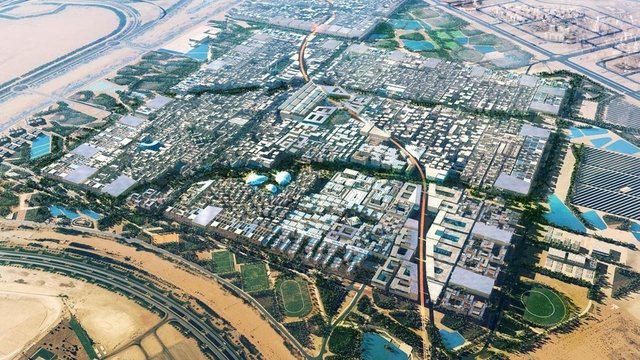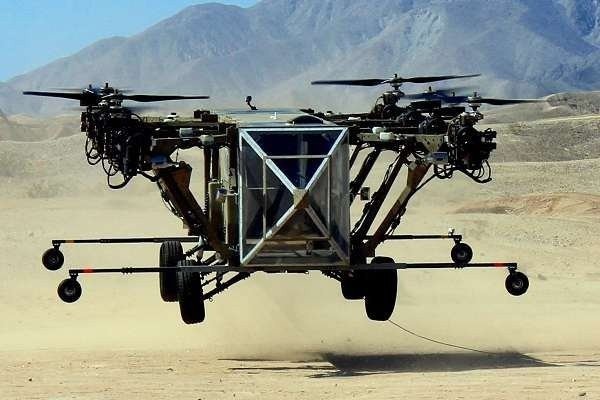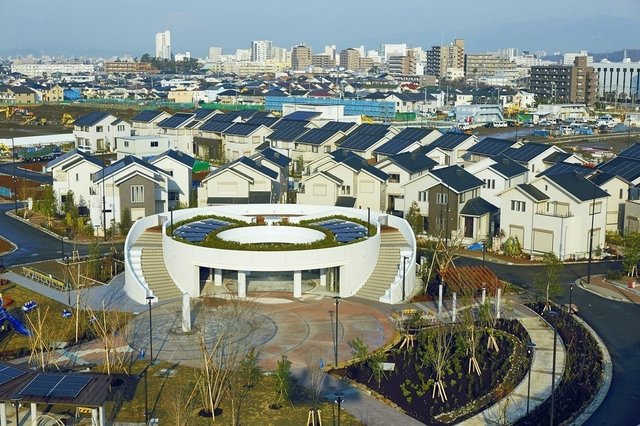How will the cities of the future look?

Architects, scientists and futurologists are trying to find an answer to the question “how the cities of the future will look; will they become a conglomeration of skyscrapers or go underground?” As the population of urbanized areas grows, along with exhaustion of Earth resources and ecological problems, the city is seen as a utopian cradle of life which implements the most ambitious urban ideas and solutions.
Today anyone can be a virtual architect: copies of real and fictional cities are being built in Minecraft, city building simulators like Anno series suggest to build megacities even on the Moon; designers are drawing concepts of towns using all achievements in building and transport logistics.
However besides of the virtual buildings, hundreds of the real towns are being built and pretending to be “smart cities”. This post will tell you about the most interesting ones.
Controlling the city

Songdo city by 2020, concept art.
The city of the future is a city where most systems and infrastructure are being controlled by computers. In Songdo district, South Korea, the prototype of entire urban information network is being tested; it will connect all buildings in one cluster. Data from the myriad of sensors and cameras will come into databases. The purpose of this system is the control and management of all urban systems, including transport, water supply, etc. We all know that the modern city services are still far from peak efficiency. Moreover, the experimental system will take care of the residents’ safety. For example, the floors of the nursing home will be equipped with sensors, through which it will be possible to detect the fall of man and send an alarm. Or another actual example: a citywide information network will produce a universal card that will act as a key to the front door of an owner’s house, a credit card, or travel pass. Routes for garbage trucks will be built using the data about fullness of the garbage cans. Also road traffic could be controlled by such a system – this is a “must have”.

Right now in Songdo you can open a door using your smartphone instead of the key! By clicking your mouse a couple of times you can consult with a doctor. An official could be contacted for administrative matters using a special app. And much more!
Songdo is located on an artificial island 50 kilometers away from the Seoul, capital of South Korea. Construction of this city, which by outsiders’ estimates cost South Korea $35bn, has been carried out for 15 years with active support of Cisco Systems. The city should be completely built by 2020 and at that time its population will be 250k citizens. In 2016, Songdo with 400 smart buildings running can claim to be the first smart city in the world.
The eternal question of traffic jams is being solved radically: you can use a well-developed public transport system instead of your own car, as well as through the implementation of telepresence technology. To achieve this it is planned to install the TelePresence video service in every home, office and public institution, which will provide the opportunity to conduct remote meetings via video surveillance systems.
Songdo is also a “green” city which actively uses renewable energy sources like solar and wind power. Rubbish is not thrown on dumps, but passed through the recycling system. The rainwater is being collected and used for watering street greenery, for toilets in buildings and for washing the streets.
A lot of countries are interested in the Koreans’ initiative, because they can potentially solve some problems of big cities. For example, New York, has turned into just a big conglomeration engulfing many small cities. 200 kilometers of the coastline to Newark are represented by the “concrete jungle”. Tokyo has already merged with Yokohama, simultaneously absorbing the hundreds of other settlements, and the population of this colossal agglomeration is about 38 million people. For example, Moscow is about to merge with other cities too, its area slowly grows like an octopus with tentacles represented by the main highways, integrating the surrounding cities. Can you even imagine how to control such complex formation?
Life without an octane number

Smog in Beijing. The elements in smog can penetrate into the body through the lungs, accumulate and sag in it.
It is considered that the main cause of smog is vehicles. And one of the main features of the future of cities is usually represented by polluted air. Motor vehicles, of course, cause the detrimental effect to the air. For example, we all know how terrible the air is in Beijing, caused by smog and the highest level of air pollution. About 25% of harmful substances in the air comes to the megapolis from the transport.
It is obvious that the emissions problem should be solved - there's no way to get around it. Probably the solution will be a slow replacement of the vehicles with internal combustion engines with the “environment-friendly” vehicles like electrocars. In this case the city of Masdar is very interesting – there the use of vehicles with internal combustion engines is forbidden by law.

Concept are of the city of future in the UAE.
Masdar is the eco-city which is half supplied by renewable energy sources and having a sustainable environment with minimal emissions of carbon dioxide into the atmosphere. It is planned to populate the city by scientists working on the advanced “green” projects and start-ups.

A street of Masdar, 2016.
The city budget is estimated at $22 billion. The project, launched in 2006, should have been completed in 2015, but due to lack of investment, the construction has not been completed so far. By the new plan, Masdar will be fully constructed by 2030. Now the city is home to about 300 people, has the basic infrastructure and one shop.

Freight drone Black Knight Transformer can deliver cargo with weight up to 1,6 tonnes.
The more radical solution is a complete rejection of the use of vehicles as delivery trucks. This task could be given, for example, to freight quadrocopters. Such experiments were carried out in many countries, including Russia - some time ago in Syktyvkar the pizza delivery service was operated only by using quadrocopters. Well, the world is not quite ready for mass deployment of quadrocopters, but these experiments imply that in future drones will overtake certain jobs.

There is another way to make the air in cities cleaner - attract citizens to ride bikes instead of driving vehicles. In terms of costs and efficiency it is much more convenient transportation, and only walking on the feet can compete in being environmentally friendly. Of course, it is impossible to forbid everyone to use the public transport and use bicycles instead. In addition, despite the blessed example of Europe, where bikes are transformed into public transport, a lot of countries could not adopt their experience, for example, because of the different climate regions. But still in fairly warm latitudes it is a quite feasible scenario, if attention is given to the construction of appropriate infrastructure for cyclists and promotion of this type of transport.
Cities with a predominance of bicycles will be fundamentally different from the "classic". However, a more likely scenario is the transition to electric vehicles or fuel cell vehicles. Today we can not imagine a city without cars. According to experts, soon there will be more than 2 billon cars all over the world, so the "problem of the exhaust pipes" needs to be solved as soon as possible.
The bond of town and village

This political slogan, which was popular in the USSR in the 1920s, clearly describes the approach to building cities, implying a very active use of greenery. The idea is not new - similar experiments were 100 years ago, and futurists were drawing conceptual sketches of future cities since the 19th century. But today, this very attractive idea conflicts with urban realities: as the population grows, the land in the cities rapidly becoming more expensive, so every square meter of lawn is under scrutiny of the builders of shopping centers, car parks and office complexes. Unfortunately, the money usually wins.
However, any citizen would prefer to live in a green city, not in the concrete jungle. One way to solve the contradictions between the interests of business and people is the use of so-called vertical farms. In fact, this is a vast structure consisting of several tiers, which are placed in the parks and hydroponic greenhouses for growing food.

The largest vertical farm in the world is now being built in the industrial zone of New Jersey. In an area of 6.5 thousand square meters about 900 tons of lettuce will grow annually. Sunlight is replaced by special LED-lamps, and land is replaced with reusable cloth. The farm uses half as much fertilizer and completely eliminates the use of pesticides.
The interest in such innovations, in the first place, is shown by agro-industrial companies. Naturally, the most actively experimenting in this direction is in Asia, where the problem of land shortage and overpopulation is known firsthand. Advantages of vertical farms are not only efficient use of urban areas, but they are not dependent on weather conditions. This is especially important for the realities of northern countries. Naturally, these objects should be computerized and automated. And the fact of their being in the city makes architects focus more on harmony and relevance of appearance.

High Line park, New York.
There are a number of bold projects involving the integration of full park areas inside the office and residential buildings including skyscrapers. In Singapore there is a hotel with a large park on 56th floor. It is too exotic for us, but the experience of New York should be considered and possibly adopted: a park in this wonderful city was created on the abandoned urban railway line.

Concept art of “Zaryadie” park, Moscow.
The most expensive sandlot in Russia, located a few steps away from the Kremlin, on the site of the demolished hotel "Russia", is now being transformed into a unique park, divided into several natural landscape zones, typical for the country. The park will have a birch grove, dwarf and creeping plants of the tundra, prairie grass, subtropical plants, coastal forest and steppe. Opening of the park is planned in September of 2017.
Electricity in the XXI century

Fujisawa, Japan.
In addition to oil and gas, modern civilization depends on electricity. And all sorts of future innovations will require more electricity. So in addition to the exciting challenges of making cities more clean and comfortable we will address the issues of increasing electricity generation and energy efficiency. One approach has been tested in Japan: an experimental town Fujisawa was built not far from the capital, in which various technologies are being tested. At first glance, there is nothing special; it looks like a typical American suburb square, but this impression is deceptive.

First, each house is equipped with solar panels and a mini-power station, which allows reduction of the total consumption of supplied electricity by several times, and carbon dioxide emissions can be decreased by 70%. When disconnecting the external power supply the town will be able to operate three extra days using the accumulated electricity.
Secondly, the automation of homes is very widely used. Washing machines choose the washing program themselves, determine the degree of contamination of clothes and necessary quantity of washing powder depending on the load. If viewers are moving away from the TV, then it turns off by itself after a while. When a pedestrian walks in the dark street, lights shine brighter, and then to go into power saving mode. Also, all the cables and communications lines are hidden when installed.
In this town it is also not acceptable to use vehicles with internal combustion engines. If necessary, you can rent an electric car or bike. Streets are equipped with multiple cameras and sensors, which made it possible to reduce the number of police officers, preserving the level of security. This year the city will test a self-driving taxi system. The experiment will be conducted on the basis of several hybrid minivans such as Toyota Estima.
Conclusion
According to the World Health Organization, by mid-century, the urban population will be 70% of Earth's population - more than 6 billion people. So we in any case will have to learn how to effectively solve numerous problems of management of the huge urban agglomerations. Even "normal" big cities will benefit from the implementation of new technologies to make the lives of city dwellers more comfortable and safer.
Fortunately, most projects which are being implemented have nothing in common with the anti-utopian ideas about the world. The era of cyberpunk with cities, one form of which plunges into severe depression, has already ended and remained on the pages of books and on footages with special effects or postponed to the distant future, which is associated with unpredictable events.